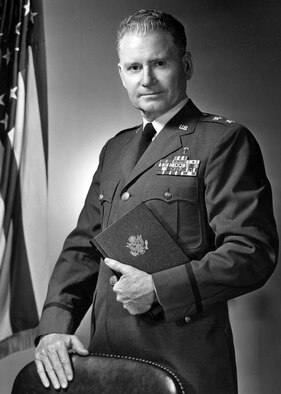
The “Missing Man Table”–complete with the offending Bible–that was recently removed from the dining facility at Patrick AFB, FL (Photo by Lt Col Steve Hyle, Ret, and posted at the KLIX Radio website
A sad little kerfuffle has unfolded at Patrick AFB, Florida in recent weeks.
It’s sad, because the controversy was totally preventable and completely unnecessary. But in today’s politically correct military, senior leaders scramble to avoid offending the smallest minority, lest that individual or group contact their Congressmen, the media–or both–and create a tempest that derails a commander’s career. Never mind that such efforts often anger the vast majority of military members and generate the same controversy the commander was hoping to avoid.
At Patrick, the sordid business began–of all places–at the base dining facility.
Like many military mess halls, the Riverside Dining Facility at Patrick proudly displayed a “POW-MIA Missing Man Table,” honoring those held captive in the nation’s wars, and those who went missing in action. The tables are a long-honored military tradition; the display includes a white table cloth setting with an inverted glass, a plate with lemon and salt, a single rose, a candle and a Bible.
According to the National League of POW and MIA Families, each element is carefully selected for its significance. The Bible “represents the strength gained through faith in our country, founded as one nation under God, to sustain those lost from our midst.”
But someone at Patrick took offense to inclusion of the Bible, so the entire display was removed last month. Bad move, because that caught the attention of airmen, retirees and other personnel who eat at Riverside. They raised cain, and late last month, the “missing” POW-MIA table made the pages of Florida Today, the largest newspaper on the Space Coast.
Once the media came knocking, base “leadership” had a change of heart. Here’s a statement they released in late March, affirming their desire to honor POWs and those missing in action, and promising to restore the display:
“The 45th Space Wing deeply desires to honor America’s Prisoners of War (POW) and Missing in Action (MIA) personnel,” commanders said in a written statement. “Unfortunately, the Bible’s presence or absence on the table at the Riverside Dining Facility ignited controversy and division, distracting from the table’s primary purpose of honoring POWs/MIAs. Consequently, we temporarily replaced the table with the POW/MIA flag in an effort to show our continued support of these heroes while seeking an acceptable solution to the controversy.”
“After consultation with several relevant organizations, we now intend to re-introduce the POW/MIA table in a manner inclusive of all POWs/MIAs as well as Americans everywhere.” the statement said.
So far, there has been no confirmation that the POW-MIA table is back on display at the dining facility.
The Patrick incident is merely the latest skirmish in the USAF’s internal war over religion, which has been raging for almost two decades. In the mid-1990s, the service began allowing Wiccans and other groups to use base chapel facilities, a move that brought complaints from Christian and Jewish airmen. Later, the Air Force became embroiled in a legal battle with a former JAG officer, Michael “Mikey” Weinstein, who claimed he was subjected to anti-Semitic comments and harassment as a cadet at the Air Force Academy in the 1970s, and his sons received similar treatment at the school three decades later.
Weinstein’s various lawsuits and threats of additional legal action put the Air Force on the defensive. Other events, including the alleged “Koran flushing” incident at Guantanamo Bay–which never actually occurred–only heightened sensitivities to perceived slights and religious offenses. Against that backdrop, it’s no wonder commanders at Patrick folded like a cheap suit and removed the offending display, replete with the Holy Bible.
And that begs another question: would the POW-MIA table still be on display if it included a Koran, the vedas, or the Tipitaka? And where were the base chaplains when this controversy erupted? Did any of them take a stand in the name of the military’s religious heritage, founded on Judeo-Christian principles?

Chaplain (Major General) Robert Preston Taylor, in his final assignment as Chief of Chaplains for the USAF. Taylor began his military career as an Army chaplain in the Philippines, where he was hailed as a hero for rescuing wounded soldiers on the battlefield, and ministering to fellow POWs after being captured by the Japanese (USAF photo)
At times like these, we wish the Air Force still had clergy like Robert Preston Taylor, who eventually became the services Chief of Chaplains (with the rank of Major General ) before retiring in 1966. Almost 20 years after his passing, Taylor remains the exemplar for military chaplains, ministering under conditions that could, quite literally, be described as hell on earth.
Chaplain Taylor’s exploits are detailed in a pair of excellent books, Ghost Soldiers by Hampton Sides and Days of Anguish, Days of Hope, a biography first published in 1972. Both describe a man of deep religious faith who never wavered from his beliefs or his duty during the darkest days of World War II.
When the U.S. entered the conflict, Taylor was a chaplain assigned to the Army’s 31st Infantry Regiment, deployed on the Bataan Peninsula in the Philippines. As Taylor’s superiors later observed, the young chaplain could often be found “at the point of greatest danger,” ministering to his flock. He won the Silver Star for rescuing wounded men on the battlefield, and volunteered to search for part of the regiment that went missing during the desperate campaign against Japanese invaders. Taylor spent a week behind enemy lines before rejoining the regiment.
With the surrender of U.S. forces in the Philippines in April 1942, Taylor became one of thousands of American POWs. He endured the terrors of the Bataan Death March, watching scores of U.S. and Filipino troops being bayoneted when the collapsed from hunger, thirst, exhaustion or illness.
The march ended at the Cabanatuan POW camp, which became the largest internment facility for Allied POWs in the Philippines. Disease quickly took hold in the weakened population, and once again, Taylor put himself in personal jeopardy, working in the prison hospital. With a dozen prisoners (or more) dying each day, Chaplain Taylor made contact with a local guerrilla network, smuggling badly needed food and medicine into the camp. His actions literally saved the lives of scores of prisoners.
Taylor’s contact on the outside was an American woman named Claire Phillips, who ran a club in Manila frequented by Japanese officers. Operating under the code name “High Pockets,” Phillips provided a steady flow of rations and medical supplies to the POWs. Unfortunately, the Japanese intercepted one of her shipments, which included a Greek New Testament inscribed to “Chap Bob,” who the guards quickly identified as Robert Taylor.
As punishment, the Japanese tortured the chaplain and placed him in the “heat box,” a suffocating, half-buried bamboo cell that was so small that prisoners could not stand erect. Taylor emerged from the box in bad shape, but he eventually recovered and continued to assist his fellow prisoners.
But Chaplain Taylor’s ordeal was far from over. With American forces poised to re-take the Philippines, Taylor was among those transferred to Japan on the notorious “hell ships;” hundreds of men crowed into the holds of old cargo vessels with little food, water, ventilation and no sanitary facilities. Some of the ships were torpedoed by American submarines, unaware that their countrymen were onboard. Others–including the vessel transporting Taylor–were attacked by our aircraft and scores of POWs died.
Taylor eventually made it to Manchuria, where he was forced to work in a coal mine until Soviet troops liberated him in August 1945. He weighed barely 100 pounds at the time of his release. Upon returning to the States, he learned his wife had married another man, after receiving a War Department telegram that listed him as “missing and believed dead” on Bataan.
Chaplain Taylor would serve another 20 years in the U.S. Air Force, eventually becoming the service’s senior cleric. In his official photo, Taylor appears to be holding a copy of the Bible, with an Air Force logo on the cover. Even as a flag officer, Taylor left no doubt about his convictions or his duties as a pastor.
I wonder what Robert Preston Taylor would think about a Bible on a POW-MIA table, and the commanders at Patrick who pulled the display, lest the Holy Book offend someone.
